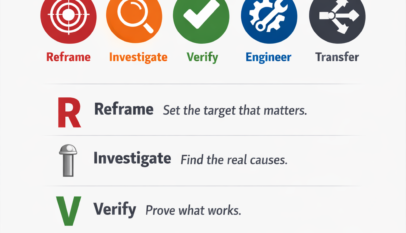Maintenance metrics are crucial for any organization aiming to optimize its maintenance operations and enhance the reliability of its systems. Let’s explore four essential maintenance metrics: Mean Time Between Failures (MTBF), Mean Time to Repair (MTTR), Failure Rate, and Reliability.
Mean Time Between Failures (MTBF)
Definition: MTBF measures the reliability of a system or component. It represents the average time between one failure and the next during normal operation.
Formula:
MTBF = Running Time / Number of Failures
Example: If a machine operates for 5000 hours and experiences 10 failures, the MTBF is calculated as follows:
MTBF = 5000 hours / 10 occurrences = 500 hours
Usage: MTBF predicts the time intervals between failures, which helps in planning maintenance schedules and estimating equipment lifespan. A higher MTBF indicates a more reliable system.
Mean Time to Repair (MTTR)
Definition: MTTR measures the average time required to diagnose and fix a failure and restore the system to full functionality.
Formula:
MTTR = Total Downtime / Total Breakdown Incidences
Example: If the total downtime for repairs is 30 hours and there are 10 breakdowns, the MTTR is calculated as follows:
MTTR = 30 hours / 10 occurrences = 3 hours
Usage: MTTR assesses how quickly a system can be repaired after a failure. This metric helps organizations understand their maintenance efficiency and plan for spare parts and staffing.
Failure Rate
Definition: The failure rate is the frequency at which an engineered system or component fails within a specified period. It is often expressed as the number of failures per unit of time (e.g., failures per hour).
Formula:
Failure Rate = 1 / MTBF
Example: With an MTBF of 500 hours, the failure rate is calculated as follows:
Failure Rate = 1 / 500 hours = 0.002 failures per hour
Usage: The failure rate helps understand a system’s reliability. A lower failure rate indicates a more reliable system.
Reliability
Definition: Reliability is the probability that a system or component will perform its intended function without failure under specified conditions for a certain period.
Formula:
Reliability = e^(-λt)
Example: With a failure rate (λ) of 0.002 failures per hour and a time period (t) of 20 hours, reliability is calculated as follows:
Reliability = e^(-0.002 * 20) = e^-0.04 ≈ 0.9608 or 96.08%
Usage: Reliability gives a quantitative measure of how dependable a system is over time. Higher reliability means the system is less likely to fail within the given time frame.
Understanding these maintenance metrics is essential for effective maintenance management. By analyzing MTBF, MTTR, Failure Rate, and Reliability, organizations can optimize their maintenance schedules, improve equipment lifespan, and ensure efficient and reliable operations. These metrics provide valuable insights that help plan maintenance activities, allocate resources, and achieve higher operational efficiency.


















